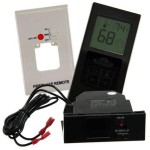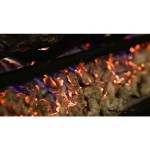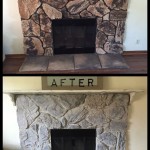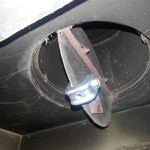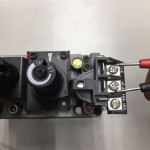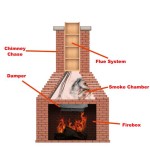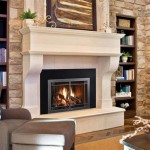Gas Heaters That Look Like Fireplaces: Aesthetics and Functionality Combined
The desire for the ambiance of a traditional fireplace, coupled with the convenience and efficiency of modern heating technology, has led to the increasing popularity of gas heaters that mimic the appearance of fireplaces. These appliances offer a compelling alternative to wood-burning fireplaces, providing warmth and visual appeal without the associated hassles of wood sourcing, storage, and ash removal. The market for these gas fireplaces encompasses a wide range of styles, sizes, and features, catering to diverse aesthetic preferences and heating requirements.
Gas fireplaces operate by burning natural gas or propane to generate heat. The flames are often designed to dance around realistic-looking logs or decorative elements, creating the illusion of a genuine wood fire. This design element is crucial to the appeal of these appliances, as it allows homeowners to enjoy the visual warmth and comfort of a fireplace without the drawbacks of traditional units. Furthermore, gas fireplaces offer a higher degree of control over heat output, allowing for precise temperature adjustments to maintain a comfortable living environment.
The integration of gas heaters into fireplace designs represents a significant advancement in home heating technology. These appliances combine the aesthetic appeal of a traditional fireplace with the convenience and efficiency of gas-powered heating. This combination allows homeowners to create a warm and inviting atmosphere while also reducing their reliance on less efficient or more labor-intensive heating methods.
Key Point 1: Advantages of Gas Fireplaces Over Traditional Wood-Burning Fireplaces
Compared to traditional wood-burning fireplaces, gas fireplaces offer several distinct advantages. One of the most significant benefits is the ease of operation. With a gas fireplace, there is no need to gather, chop, or store wood. The appliance can be ignited with the flip of a switch or the press of a button, providing instant heat and ambiance. This convenience is particularly appealing to individuals with busy lifestyles or those who are unable to physically manage the demands of a wood-burning fireplace.
Another advantage of gas fireplaces is their superior efficiency. Wood-burning fireplaces are notorious for their low efficiency ratings, with a significant portion of the heat escaping up the chimney. Gas fireplaces, on the other hand, are designed to maximize heat output and minimize heat loss. Many models are equipped with features such as sealed combustion chambers and direct vent systems, which further improve efficiency and reduce energy consumption.
Safety is another crucial factor to consider. Wood-burning fireplaces pose a fire hazard if not properly maintained and operated. Embers can escape from the fireplace, potentially igniting nearby materials. Gas fireplaces are generally safer, as they are designed with safety features such as automatic shut-off valves and flame sensors. These features help to prevent gas leaks and ensure that the appliance operates safely and reliably.
Finally, gas fireplaces produce significantly less air pollution than wood-burning fireplaces. Wood smoke contains particulate matter and other harmful pollutants that can negatively impact air quality and human health. Gas fireplaces, on the other hand, burn cleaner and produce fewer emissions. This makes them a more environmentally friendly option for heating homes.
Key Point 2: Design and Style Options for Gas Fireplaces
Gas fireplaces are available in a wide range of designs and styles to complement various home décor aesthetics. From traditional to contemporary, there is a gas fireplace to suit virtually any taste. Traditional gas fireplaces often feature ornate mantels, brick or stone surrounds, and realistic-looking logs. These models are designed to replicate the look and feel of a classic wood-burning fireplace, providing a warm and inviting focal point for any room.
Contemporary gas fireplaces, on the other hand, tend to have a more minimalist and modern design. They often feature clean lines, sleek surfaces, and glass fronts. These models may incorporate decorative elements such as glass beads, river stones, or ceramic logs to create a unique and visually appealing display. Contemporary gas fireplaces are a popular choice for homeowners who prefer a more modern and sophisticated look.
In addition to traditional and contemporary styles, gas fireplaces are also available in a variety of other designs, including freestanding models, wall-mounted units, and insert fireplaces. Freestanding gas fireplaces can be placed anywhere in a room, providing flexibility in terms of placement and design. Wall-mounted gas fireplaces are a space-saving option that can be easily installed on any wall. Insert fireplaces are designed to be installed in existing fireplace openings, allowing homeowners to convert a wood-burning fireplace to a gas fireplace without the need for extensive renovations.
The choice of materials used in gas fireplace construction also plays a significant role in the overall aesthetic. Common materials include steel, cast iron, brick, stone, and glass. Each material offers its own unique look and feel, allowing homeowners to customize their gas fireplace to match their individual preferences.
Key Point 3: Considerations for Choosing a Gas Fireplace
Selecting the right gas fireplace requires careful consideration of several factors. One of the most important considerations is the size of the room in which the fireplace will be installed. A larger room will require a more powerful fireplace to provide adequate heat. Conversely, a smaller room may only require a smaller, less powerful fireplace.
The type of fuel used by the gas fireplace is another important consideration. Gas fireplaces can be fueled by either natural gas or propane. Natural gas is typically more affordable than propane, but it is not available in all areas. Propane is a more versatile option, as it can be stored in tanks and used in areas where natural gas is not available. However, propane tanks require regular refilling, which can add to the overall cost of operation.
The venting system used by the gas fireplace is also a critical consideration. Gas fireplaces can be vented in several different ways, including direct vent, vent-free, and B-vent systems. Direct vent systems are the most efficient and safest type of venting system. They draw air from outside the home for combustion and vent exhaust gases directly outside. Vent-free systems do not require any venting, but they are not recommended for use in bedrooms or other enclosed spaces. B-vent systems use existing chimneys or flues to vent exhaust gases outside the home.
Finally, the features and options offered by the gas fireplace should also be considered. Many gas fireplaces are equipped with features such as remote controls, thermostats, and variable flame height settings. These features can enhance the convenience and comfort of using the fireplace. Some gas fireplaces also offer optional accessories such as blowers, which can help to distribute heat more evenly throughout the room.
Ultimately, the best gas fireplace for a particular homeowner will depend on their individual needs, preferences, and budget. By carefully considering these factors, homeowners can choose a gas fireplace that provides warmth, comfort, and visual appeal for many years to come. The installation process is best left to qualified professionals to ensure safe and efficient operation of the gas fireplace. This includes checking for gas leaks and ensuring proper venting.
The ongoing maintenance of gas fireplaces is minimal compared to wood-burning fireplaces. Regular cleaning and inspection of the burner and venting system are typically all that is required to ensure optimal performance and longevity. This further contributes to the convenience and appeal of gas fireplaces as a home heating solution.
The initial investment in a gas fireplace may be higher than that of some other heating options. However, the long-term cost savings associated with improved energy efficiency, reduced maintenance, and the elimination of wood-related expenses can make gas fireplaces a cost-effective choice over time. This makes it a good investment considering its many advantages.

Gas Fireplaces Inserts Stoves And Heaters The Hearth

Lopi Cypress Freestanding Gas Fireplace Hawkesbury Heating

Vented Gas Logs Heater Or Decorative Bart Fireside

Gas Log Fireplaces Jetmaster

Do Gas Fireplaces Heat A Room Contact The Flame Company Today

Gas Fireplaces Inserts Stoves And Heaters The Hearth

Nectre Gas Flame Range In Built Log Fires Heatworks

Radiance Vent Free Gas Stove The Place

Gas Log Fireplaces Jetmaster

Napoleon Gds50 The Fireplace King Huntsville Ontario Muskoka For Your Heating Cooling And Grilling Needs
Related Posts

